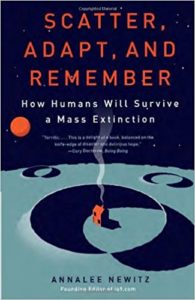
Come what may, the human race is heading toward a fall.
As Berkeley Ph.D. Annalee Newitz writes, “the world has been almost completely destroyed at least half a dozen times already in Earth’s 4.5-billion-year history . . . Each of these disasters caused mass extinctions, during which more than 75 percent of the species on Earth died out. And yet every single time, living creatures carried on, adapting to survive under the harshest conditions.”
Estimated reading time: 4 minutes
In Scatter, Adapt, and Remember, Newitz explores what humankind must do to be among the survivors of the next mass extinction. Because, as she emphasizes, there will inevitably be a next time. If the current acceleration in species death — think honeybees and frogs — isn’t an early stage of a full-blown mass extinction, something else really, really bad will surely happen sooner or later. Thus it is, Newitz insists, “we need a long-term plan to get humanity off Earth. We need cities beyond the Blue Marble, oases on other worlds where we can scatter to survive even cosmic disasters.”
Scatter, Adapt, and Remember: How Humans Will Survive a Mass Extinction by Annalee Newitz ★★★★★
For me, as a long-time science fiction reader (and once-upon-a-time sf writer), this assertion is not news. Nor are the apocalyptic scenarios she paints, with massive asteroids or comets crashing into the Earth, megavolcanos blanketing the Earth with soot and ash that trigger an Ice Age, bursts of cosmic radiation frying all life on the planet, an incurable contagious disease gone pandemic, or, worst of all — here’s the surprise — climate change.
Yes, it turns out that the worst of the half-dozen mass extinctions science has brought to light “involved climate change similar to the one our planet is undergoing right now.” During that distant period, around 250 million years ago, “95 percent of all species on the planet were wiped out over a span of roughly 100,000 years . . .” And lest you take comfort in the hope that our brush with such a catastrophe lies in the distant future, please note that some in the scientific community date the beginning of the current mass extinction to a time about 15,000 years ago when human invaders from Asia began to exterminate the giant fauna of the Americas (mammoths, giant elk, sloths, and other species).
Newitz, a science journalist and award-winning blogger, divides Scatter, Adapt, and Remember into four sections. In Part I, she surveys the history of mass extinctions. Part II focuses on homo sapiens‘ close calls — from the population bottlenecks in the earliest days of our species in Africa a million years ago, to our recent competition with Neanderthals and homo erectus, to the horrific pandemics that have lowered our numbers, to the widespread incidence of famine throughout our history.
Successful strategies for survival
In Part III, Newitz examines the successful strategies employed by homo sapiens and other species (including microbes and gray whales) to survive in the face of existential threats. These strategies give the book its title: Scatter, Adapt, and Remember. Part IV makes the case that humanity will only survive in cities and explains “How to Build a Death-Proof City” in which every surface is used to grow food. Part V looks to the far future — a million years or more — with humanity spreading out to the stars.
Scatter, Adapt, and Remember features excerpts from the author’s face-to-face interviews with scientists working on the frontiers of exploration in synthetic biology, nanotechnology, materials science, and many other contemporary fields. There’s scarcely a chapter without a smattering of references to working scientists. Newitz’s views emerge from a solid base of understanding of the latest findings in a wide range of scientific inqiury.
However, Newitz also reveals her love for science fiction by drawing ideas and examples from the work of some of the craft’s most celebrated writers (as do many practicing scientists and engineers, not so incidentally). In particular, she calls out the work of the late Octavia Butler to illustrate the ethical quandaries posed by the threat of extinction in one possible far future for humanity.
Alternately troubling and inspiring, Scatter, Adapt, and Remember is ultimately an intrinsically hopeful proposition from a brilliant young visionary. Annalee Newitz is a name to watch.
For related reading
For my review of another of Annalee Newitz’s nonfiction books, see Four Lost Cities: A Secret History of the Urban Age by Annalee Newitz (Join archaeologists at work around the world).
This is one of the books I’ve included in my post, Gaining a global perspective on the world around us.
It’s also one of 20 good nonfiction books about the future and of Good books by Berkeley authors. You might also enjoy Science explained in 10 excellent popular books.
If you enjoy reading nonfiction in general, you might also enjoy:
- 10 great biographies
- My 10 favorite books about business history
- 20 top nonfiction books about history
- The 10 most memorable nonfiction books of the decade.
And you can always find my most popular reviews, and the most recent ones, on the Home Page.




























good to read an intelligent review of an interesting book i might not have time to read. many thanks.